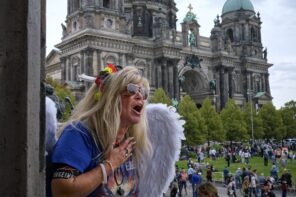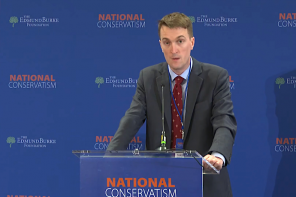For Mormons, July 24 is Pioneer Day, a holiday commemorating the date when Brigham Young and an original band of Mormon pioneers entered the Salt Lake Valley in 1847.
My grandmother’s grandmother, Rachel Jane Wight, was three years old when she made the journey in 1852 with the Thomas Howell Handcart company, her family pulling their belongings in a handcart from Council Bluffs, Iowa, westward across the plains to Salt Lake.
When I was a little girl in a Southern California suburb, I donned a pioneer calico bonnet and skirt handmade by my mother every July 24 to celebrate my great-great-grandmother and other ancestors who had come from as far away as England to build an American Zion in Utah and Idaho.
As an adult, I have reclaimed the holiday. My daughters and I have a new set of calico pioneer bonnets. (Mine is hot pink.) And every year I invite non-Mormon friends over for a Pioneer Day dinner, to share in the recounting of stories from our pioneer family history over a dinner of Mormon ethnic cuisine: funeral potatoes, frog-eye salad, iceberg lettuce with ranch dressing, white rolls, and at least two Jell-O dishes.
But this year the holiday is taking on special meaning for me in the context of debates about immigration that have been roiling the Mormon West.
After all, the place we now call Utah was actually Mexico when Brigham Young and the original band of pioneers arrived. Which means our beloved Mormon pioneers were probably illegal immigrants too.
The immigration debate has brought out some real ugliness in the Book of Mormon-belt, including the nationally-publicized release of a watchlist of 1300 alleged illegal immigrants in Utah composed by an anonymous vigilante group.
But for me the deeper story here is about how Mormons— Anglo, Latino, and otherwise—are grappling with our tradition’s growth into a global religion of more than 13 million members.
Today, Mormons include both Russell Pearce, the author of Arizona’s controversial anti-immigrant SB 1070, as well as thousands of undocumented Latino immigrants living in the United States.
There are now about as many Mormons living in Mexico and Central America as there are in Utah, and worldwide, about 4.5 million Church members are Spanish-speaking. The LDS Church’s strongest growth in the United States is in Latino communities.
The old American saying that “Sunday is the most segregated time of the week” holds largely true for Mormonism too. Even though Mormon congregations are organized geographically, Spanish-speaking members and English-speaking members living in the same communities often attend different services. Still, many of the conservative Anglo-Mormons I know here in Southern California work alongside with or provide ecclesiastical and personal support to working-class Latino Mormon immigrant families. And many have benefited personally and financially from the underpaid immigrant labor that has refigured California’s economy.
Complicated relationships, difficult questions, and few easy answers: immigration reform will take, as LDS Church leaders pointed out in an offical statement last week, “the best thinking and goodwill of all across the political spectrum.” Which means, as the old pioneer hymn goes, we’ve got to “put our shoulder to the wheel.”
If our pioneer ancestors came west to build Zion, how Mormons respond to the immigration crisis will tell us much about the contemporary vision of Zion we can claim.
This July 24, I will celebrate the undocumented immigrants who share my faith and call themselves Mormons, as well as the Anglo-American Mormons who are thinking carefully, ethically, and pragmatically about immigration reform. Both are pioneers for a global Mormon 21st century.



